How to grow cucumbers under the covering material
This garden crop grows well in warm conditions with sufficient, but not too much, sunlight. It is difficult to grow a good harvest of cucumbers. In early spring, these plants can die from frost. In the summer they suffer from extreme heat and lack of moisture. There are also many types of insects and microorganisms that can harm cucumbers.
To cover the cucumbers on top, it is recommended to use PVC film, polyethylene or white spunbond
Appropriate protective materials will help to solve all the listed problems. For shelter from above, use ordinary or bubbled polyethylene, as well as PVC film. There are also reinforced versions of such canvases - to give them greater strength. As a top cover for cucumbers, you can use white spunbond or its analogue of low density - about 28 g / m² (the same density is also suitable for tomatoes).
The advantage of the latter option is the ability to water the seedlings from above. The liquid will seep directly through the fibers of the material. In addition, agrofibre traps ultraviolet rays, redirecting only the soft part of the sunlight spectrum to the cucumber seedlings.
The best option for laying the ground in the garden is non-woven agrofiber. This black weed cover material has several advantages. It is easy to make holes in it. Through them, plants are watered and fertilized (as a rule, with rotted foliage, compost or manure). At the same time, moisture practically does not evaporate from the soil, which means that watering cucumbers can be carried out much less often. The access of insect pests to plant roots will be significantly hampered.
White spunbond allows you to water cucumber seedlings from above, and it also lets in the sun's rays
The optimum temperature for growing cucumbers is 20 ° C during the day and a few degrees lower at night. The use of covering materials allows you to maintain the required temperature directly in the open air, without placing plants in greenhouses.
When using agrofibre, it is enough to moisten cucumbers only twice a week (after planting in mid-spring). The best way to fertilize is by sprinkling with sodium humate dissolved in clean water. Concentration - one spoonful of ingredient per bucket.
Black covering material: the pros of using it
Weed grass on a land plot brings tangible harm. The most effective way to control weeds is to remove them by hand, but this is physically difficult. In addition, certain types of weeds reproduce by growing parts of rhizomes and shoots remaining in the ground. Therefore, weeding has to be carried out several times during the season.
To help gardeners, manufacturers have developed and put on sale a special covering black material. It freely passes precipitation and air, but completely blocks the sun's rays. No weeds can survive in such conditions. This material is often referred to as black spunbond, which is not entirely accurate. Spunbond is both the name of the trademark and the name of a special technology for the manufacture of nonwoven fabric. Covering materials from such companies as Agrotex, Lutrasil, Agrospan, Lumiteks, Agril and others are widely represented on the Russian market.

The black material allows air and water to pass through, but at the same time completely blocks the sun's rays
It is very important to use agrofibre correctly:
- wait until the soil dries out after the winter period;
- use any sharp or cutting object to make cuts in places where plants are planned to be planted;
- spread black material over the entire area of the beds.
Such agrofibre is called mulching. The benefits of its use are the absence of the need for weeding, as well as earlier ripening of vegetables and berries. In particular, a bed of strawberries under a black cover material can yield up to two weeks earlier than usual. The advantage is that ripe berries do not come into contact with the ground, which means they are less dirty. Thus, water consumption for cleaning the crop before selling it is reduced.

Dense black agrofiber prevents weed growth
Relatively recently, they began to use black and white covering materials. This know-how looks like this: the black side of the canvas is laid on the ground, the white color remains on top. Its surface reflects the sun's rays well on the plants growing in the slots, which has a beneficial effect on their growth.
Spunbond where the top is where the bottom. Maximum density black spunbond - help in the fight for the ideal site
I want to tell you about how I master the virgin soil on my site. Having tried many means to cover the sod and stop the growth of grass, I opted for using it with cardboard or newspapers, which I put under it, I fix it on top with such pegs. They are very comfortable, but if they are not enough, I just put something heavy on top. But I use the Agrotex 60 black version without cardboard, but I stack it twice, then not a single weed breaks through! The most persistent grow under it, pale, and still disappear afterwards.
But I use the Agrotex 60 black version without cardboard, but I stack it twice, then not a single weed breaks through! The most persistent grow under it, pale, and still disappear afterwards.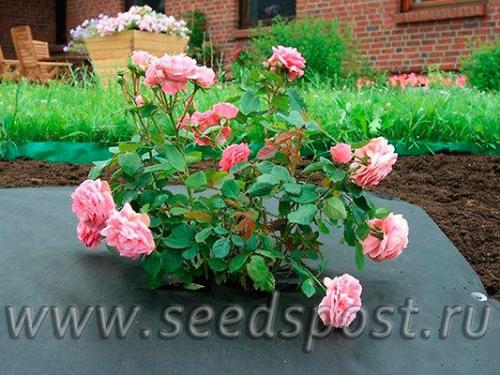 Agrotex Enough Agrospan for at least 3 years. But it seems to me that it will last much longer, because I did not notice any changes in its structure over the 3 years that I have been using it. It did not break through, did not crumble. By the way, a UV stabilizer is included in a modern spunbond, so it should serve for a long time! After removing the agrospan, clean land remains, not overdried, without vegetation. You can calmly cultivate at will, without unrealistic labor exploits and ruined health! I want to show you my options for using dense Agrospan in photos:
Agrotex Enough Agrospan for at least 3 years. But it seems to me that it will last much longer, because I did not notice any changes in its structure over the 3 years that I have been using it. It did not break through, did not crumble. By the way, a UV stabilizer is included in a modern spunbond, so it should serve for a long time! After removing the agrospan, clean land remains, not overdried, without vegetation. You can calmly cultivate at will, without unrealistic labor exploits and ruined health! I want to show you my options for using dense Agrospan in photos: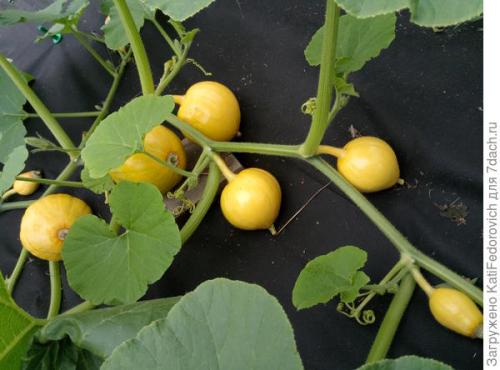 pumpkin on agrospan 60
pumpkin on agrospan 60 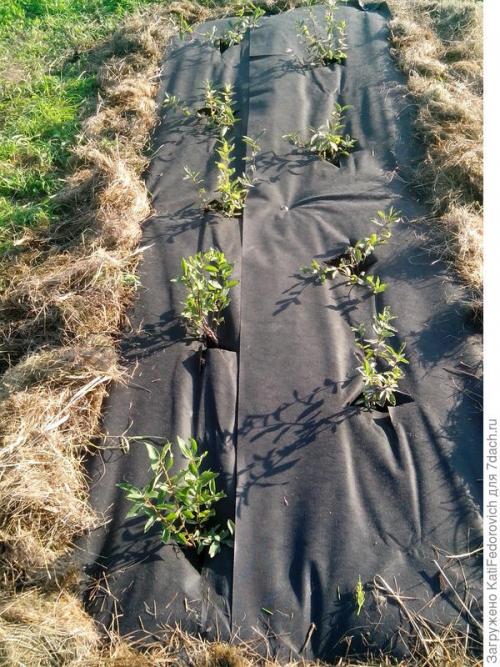 honeysuckle planted in agrospan 80
honeysuckle planted in agrospan 80 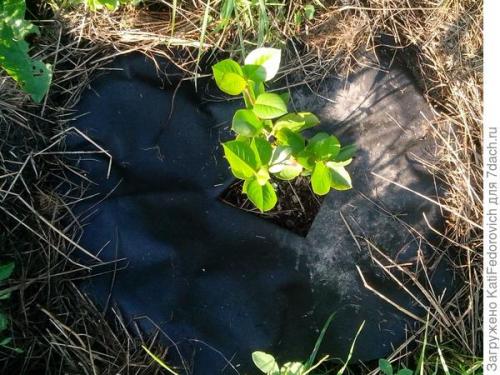 small sapling saved from grass
small sapling saved from grass 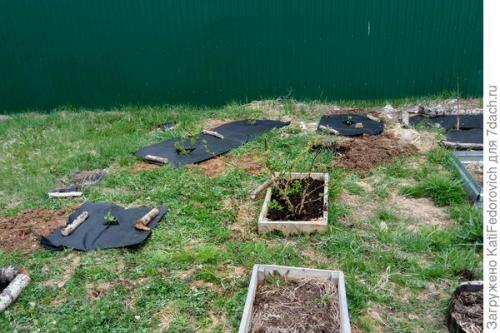 Around fruit bushes
Around fruit bushes 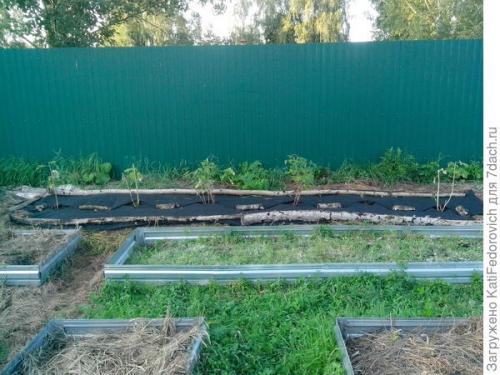 This is the release of the land behind the beds with the help of covering material. I was lying for 2 years and on the third I was able to plant plums there and sow everything with marigolds, it turned out a 6-meter strip and not a single enemy scout! Now on my site all the places that need to be vacated are closed by the agrospan. This year, at the vacated place, there is a queue for planting my flowerbed in a natural style. Also, with agrospan, I have protected seedlings of columnar apple trees and there are two 20-meter "right of way" from the neighboring weeds.
This is the release of the land behind the beds with the help of covering material. I was lying for 2 years and on the third I was able to plant plums there and sow everything with marigolds, it turned out a 6-meter strip and not a single enemy scout! Now on my site all the places that need to be vacated are closed by the agrospan. This year, at the vacated place, there is a queue for planting my flowerbed in a natural style. Also, with agrospan, I have protected seedlings of columnar apple trees and there are two 20-meter "right of way" from the neighboring weeds.
Film for beds
Black film is used with the same success. But, choosing how to cover the beds, take into account that:
- polyethylene does not allow moisture to pass through - only drip irrigation;
- the service life is shorter: it bursts from frost and heat.
Reinforced

Differs in a longer service life, since the middle layer is a reinforcing mesh that increases wear resistance. On top of such a light-colored material that reflects light.
A silvery or gold coating protects the soil and roots from overheating. The bottom layer - black - drowns out the growth of weeds.
Unreinforced
Plain thick film, single layer, costs less, but also lasts less. It is more profitable to use it for varieties with a shortened life.
Which side to lay the white agrofiber. Alternative to weeding
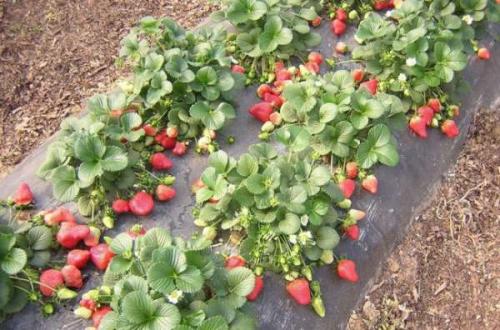
It is more pleasant to care for strawberries growing on a covering material, and the berries do not get dirty from the ground.
Weeding a strawberry plantation is a time consuming job, and you have to do it several times per season.A convenient solution to this problem has been found: the surface of the land in the garden bed is lined with special materials that suppress the growth of weeds. At the same time, compact strawberry bushes continue their normal development.
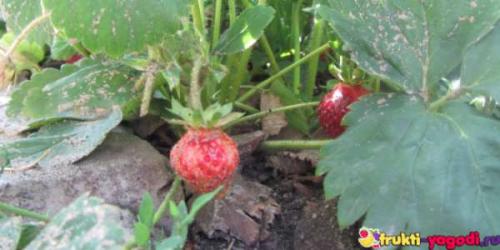
When watering, the soil fell on the strawberry fruits, if mulching had been used, this would not have happened!
What and how to cover the soil? The best material is black agrofibre. In addition, black plastic film, roofing felt, roofing felt, newspapers and pieces of cardboard, a thick layer of straw or other mulch are used for the same purposes.
English version (organic mulch)
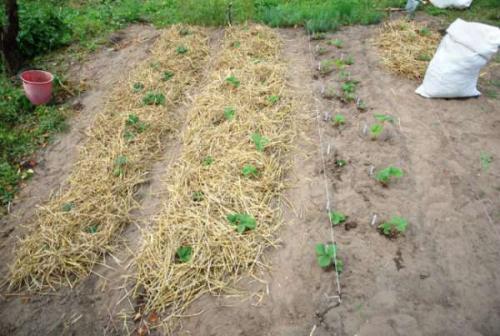
Organic mulch needs to be renewed once or twice a season.
It is known that the British call strawberries "straw berries" because they put straw under the bushes so that the berries do not get dirty from the ground.
Instead of straw, you can use pine needles, wood chips, pieces of bark and other organic materials. Fresh mulch partially inhibits the development of weeds, but for this its thickness must be at least 8 cm, with annual renewal.
Weed seeds, falling on loose mulch, still germinate. Cardboard or newspapers have a denser structure, but they quickly get wet and lose their properties. All these improvised means do not guarantee complete protection of the beds from weeds.
Finnish experience (black polyethylene)

Mulching strawberries with foil is not the best option due to certain disadvantages.
Before the advent and active spread of agrofibre, they came up with a technology for preliminary covering strawberry beds with black plastic wrap (or tar paper, roofing felt).
At the same time, young rosettes are planted in small cruciform incisions. This method has shown good results in a northern country like Finland. In Russia, it is still used by some gardeners.
Disadvantages of Finnish technology:
- the film must be of high quality and expensive, otherwise it quickly bursts, collapses;
- the soil does not breathe;
- strawberry roots overheat, rot (hot, condensation);
- it is advisable to lay a drip irrigation system under the film.
Positive aspects:
- no weeds;
- the mustache does not grow, it is convenient to remove them;
- pests (such as weevils) have nowhere to winter;
- the berry is clean (no dirt and rot);
- it is convenient to harvest the crop;
- heat accumulates and fruiting is accelerated.
Black agrofibre
Agrofibre (non-woven covering material) of black color is very convenient to use for mulching the soil. It possesses all the positive properties of a mulch film without its disadvantages.
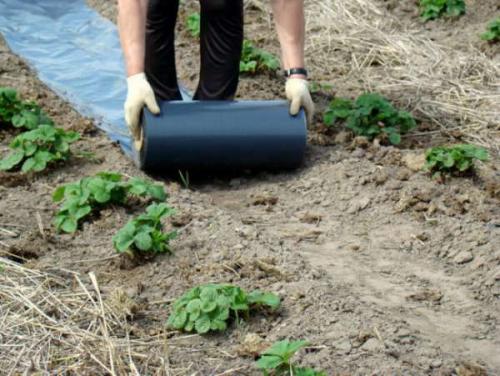
It is convenient to work with a covering non-woven material and it serves for a long time.
Weed control mulching fabric has additional valuable qualities:
A very comfortable environment is created for strawberry plants.
Varieties of black covering material
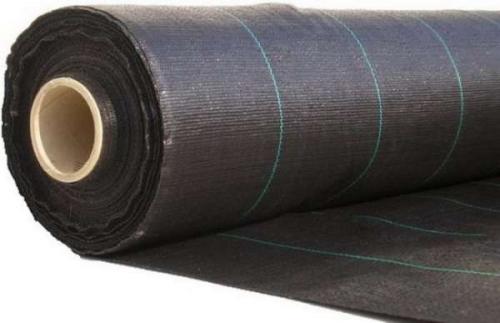
All covering materials are united by the ability to pass moisture and air.
Agrofibre from various manufacturers is produced using a similar technology. Names may differ for different brands:
The thickest and most durable material is No. 60 (this is an indicator of high density).
In recent years, a two-layer version (white-black or yellow-black Agrotex) has become widespread. The lower black side prevents weeds from growing, and the upper light side protects the roots and the aerial part of the bush from overheating. Two-layer Agrotex is convenient to use on hot southern slopes, in greenhouses and greenhouses, in southern regions.

The outer white layer of Agrotex saves from overheating, and the inner black layer absorbs sunlight and keeps weeds.
Rules for the use of nonwoven fabric
Tips for a gardener who is going to plant strawberries for the first time on agrotextile:
- The material is placed on the ground with the smooth side, and to the sun - rough, perforated. So through the holes, the water during watering or during the rain will not roll off the fabric, but will be saturated. Solar filters also work with this arrangement.
- A two-layer canvas is also laid correctly: white side down, black side up.
- Watering strawberries under agrofibre under the root is better pointwise, and not from a hose or watering can. Water that gets on the covering material will be absorbed. But repeated wetting and drying under the sun shortens the life of agrotextile.
- Light and thin (less than 60 g / m2), it will let in not only the sun and water from above, but also weeds from below. A strawberry plantation is being equipped for several years - there is no point in saving.
- Too large planting slots - a free path for the weeds to free, and the mustache to the ground. They fix not only the ends, edges, but also holes so that the grass does not break through the edge.
- The slots are made after the material has been completely fixed in the garden bed: otherwise the fabric will move out, the planting pattern will be disrupted.
- The plantation is shaded from the scorching sun with a thin white linen, and the berries are protected from birds.
Given these nuances, the gardener will cope with the simple technology of growing strawberries on agrotextile.
Mulching materials
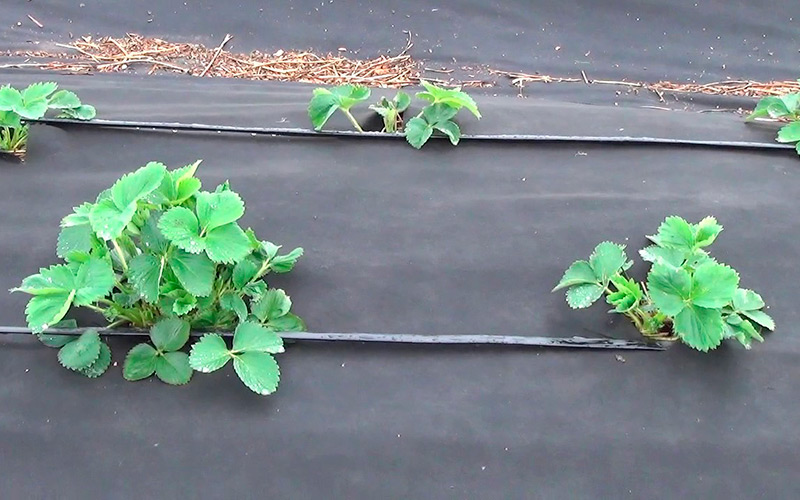
In fact, strawberry film or any geotextile is mulching. They use a simple agricultural technique to facilitate the care of a demanding crop. And in regions with rare precipitation, it reduces the consumption of irrigation water.
Organic mulch (at least 8-10 cm) or dense covering material (1 layer) gives the gardener the following benefits in open ground and greenhouses:
- the intensity and frequency of watering is reduced: under the shelter, moisture lasts longer;
- weed growth is inhibited - weeding is not needed;
- no need to constantly loosen the ground;
- film, fabric or organic mulch protect the fertile layer from being blown out by winds, erosion by rainstorms;
- it is easier not only to take care of - harvesting takes less time and effort, since the berries lie on mulch, film or fabric;
- the quality of the crop is higher: without contact with the ground, the fruits are not affected by rot.
In mulch-covered soil, strawberries are warmer in winter, and in spring the earth warms up faster.
Organic
Natural materials for mulching strawberries:
- straw;
- sawdust after a couple of years of overheating, soaked in carbamide, because they draw nitrogen from the soil;
- needles (increases acidity - you have to add deoxidizers);
- cut weeds or green manure, compost: constant renewal of the layer, which, by rotting, provides additional nutrition to the berry bushes.
Since organic matter is a living environment, mulch will not protect against pests, fungi, bacteria. The nutrient layer of green manure also feeds weeds that feed on the enriched soil.
Inorganic mulch
Chemical industry products - agrotextile and plastic wrap - as mulch give gardeners additional benefits:
- the mustache is not able to take root, since it does not reach the ground: Victoria will not be able to multiply uncontrollably;
- on strawberry plantations covered with black material in spring, the soil warms up 1.5-2 weeks earlier - the harvest is maturing ahead of schedule compared to traditional agricultural technology;
- having packed a bed when planting young bushes, the summer resident does not care about updating the shelter for a couple of years, if you use a film, and the entire life cycle of strawberries is 4 years, if grown under agrofibre;
- for many pests under the material, unfavorable conditions.
Disadvantages:
- even inexpensive agrofibre requires material costs;
- the better and more durable the covering cloth, the more expensive it is;
- to water strawberries, you will have to install drip irrigation systems.
If the owners of small land plots still choose how to plant strawberries - under a shelter or in the old fashioned way, then large farms can no longer do without modern technologies.
How to use weed cover material correctly
In order for the use of a covering material to be effective, it must be used correctly.Traditionally, the bed is first covered with a film or cloth, and then cross-shaped holes are made in it, into which seeds or seedlings are planted. But in practice, it is much easier and more convenient to make small round holes, since the edges of the cruciform slots can interfere with the growth of crops (Figure 2).
Figure 2. Application of agrofibre in the beds
If you plan to cover a garden with carrots, beets, radishes or other vegetables, the seeds of which are planted directly into the ground, with agrofibre, you can simply spread the material on the ground, and when the crops germinate and get stronger, simply remove the shelter for further development of sprouts.
The correct use of covering material in the beds looks like this:
- The soil on the bed must be carefully leveled and all lumps must be broken so that the surface is perfectly flat.
- We lay out the canvas next to the bed and make marks on it for future cuts.
- You can use a small saucer to make an even circle. Cruciform incisions are made with an ordinary knife. The distance between the holes is on average 40-45 cm, but this depends on the type of plants being grown. it is not recommended to reduce the distance between the holes, as too dense planting will deprive plants of light and air, and they will develop more slowly.
- The canvas prepared in this way is laid out on the garden bed and its edges are fixed with pegs, bricks or small stones.
After that, it remains only to plant seedlings or seeds in the prepared holes. Taking care of crops is also quite simple: since there is no need to loosen and remove weeds, all care comes down to periodic watering and feeding directly into the holes.
In addition to the technology of using the covering material, you need to choose the right type of it. A wide range of similar products is presented on the modern market, ranging from black film and agrofibre to white and colored non-woven fabrics. Each of them has its own advantages and disadvantages, so we will consider the features of using the most popular types in more detail.
Black agrofibre
Black agrofibre has many benefits, so it is no surprise that it is the most commonly used for weed control (Figure 3).
Of the main advantages of black agrofibre, it is worth highlighting:
- Reduced labor and financial costs: Weeds simply do not grow under such a fabric, so you do not have to spend money on buying herbicides or wasting energy on constant weeding.
- Fruit purity: if you grow strawberries or other berries under such agrofibre, you do not have to wash them from the remains of the earth, since the fruits are on the surface of the fabric and dirt and sand do not settle on them.
- Acceleration of crop growth: this coating speeds up seed germination, since the soil under the dark agrofibre warms up much faster than in the beds without it.
Figure 3. Areas of application of black agrofibre
At the same time, such a canvas is not recommended for use in a southern climate, where the soil is strongly warmed up by the sun. But, if you still want to use exactly black material, then on top of it you need to additionally cover it with a layer of light mulch, for example, hay, straw or sawdust.
Two-tone or white fabric
White and two-tone agrofibers are also popular. The first type of material can be used in any climatic and soil conditions. Like black, white linen protects the beds from germination of weeds, but at the same time allows a sufficient amount of solar heat, air and moisture to pass to the cultivated plants (Figure 4).
Figure 4. External features of a two-color covering material
A more modern option is a two-tone fabric. It appeared on the market relatively recently, but has already established itself as a reliable protection against weeds.One side of the canvas is white and the other is black. Such material should be laid with the black side to the ground, and the white side out. This will reflect sunlight off the fabric, but heat will be absorbed by the darker underside. As a result, the plants will receive more heat and grow faster. At the same time, ripening occurs evenly, since the roots of young seedlings do not overheat.
Non-woven covering material
Spunbond, agril, agrotex, lutrasil, agrospan ... How not to get confused in front of a counter with non-woven materials and what to choose? The essence of all these materials is the same, only the manufacturers are different, so you can safely take packaging with any name, focusing only on the characteristics of the covering material.
First of all, you should be interested in density and color, because it depends on them where this shelter can be applied. The density of spunbond and similar materials is of 3 (sometimes 4) types:
- 17-30 g / m2 - the thinnest and lightest (and also the cheapest) material; protects plants from short return frosts, scorching sun, insects and birds, great for sheltering the first greens and vegetables in the open field, wrapping bushes and trees during the ripening period of the crop;
- 42-60 g / sq.m - suitable for the construction of greenhouses with arches, compact greenhouses, winter shelters for decorative and fruit crops that are afraid of frost;
- 60 g / m2 - the densest and most expensive option; serves for several seasons in a row, is used for the construction of shelters for plants, is often made using UV stabilizers, which further extends the shelf life of the material.
Spunbond - how to choose and use agrofibre correctly
Choosing the right agrofibre to protect plants from frost, hail, insects, birds and weeds.
White covering material
White non-woven covering material is widely used in the garden and vegetable garden. With its help, you can perform the following work:
- shade the first shoots from the sun's rays;
- create an optimal microclimate for greens and vegetables that do not need pollination;
- protect plants from birds and pests;
- cover the greenhouse, greenhouse, build a temporary shelter;
- organize a winter shelter for crops in need of such a measure.
Black covering material
Covering, or mulching, material from weeds is similar to its white "brother" only in the manufacturing method, but differs in characteristics and functions. It is laid on the ground in order to reduce evaporation, increase soil heating, protect plants from excess moisture and dirt, and also minimize weeding and loosening work.
The soil under such material remains moist and does not become crusty from irrigation, and pests have nowhere to hide on its surface, so it is easier to eliminate them. In fact, planting strawberries on a covering material reduces all crop care to watering, feeding and picking berries. However, the same goes for other crops grown under black nonwoven fabric.
Double layer nonwovens
If you see that the sides of the covering material differ in color, be aware that this is not done for beauty. Usually the bottom of such material is black and works as mulching, and the top is white, yellow or foil. This side reflects sunlight and illuminates the plantings from below, significantly accelerating the ripening of the crop.
Even solid color nonwoven covering materials have a front (top) and back (bottom) side. They only allow water to flow from top to bottom to ensure easy watering and reduce liquid evaporation. In order not to be confused, you need to mark the sides right at the time of purchase. If you haven't, wash a small piece of material, dry it, and then sprinkle water on one side. If the water easily seeped inside, then this is the front side, if it spreads over the surface - the wrong side.True, this only works with materials denser than 17-30 g / m2, and thinner materials let water pass in both directions.
Types of nonwoven weed coverings
Agrocloth for weeds is sold on the market in a very different category of quality and price. You can choose a product according to color, density, structure and other preferences and needs.
Spunbond
The brand became so popular that summer residents began to call this word any covering material for the beds. Spunbond is a special fabric production technology. It turns out to be light, airy, but we fix it. The material is environmentally friendly, it is not affected by temperature fluctuations and mechanical stress.
In color, spunbond is white and black, in density - 20-60 g / m2:
- White material up to 30 g / m2, used mainly to protect crops from recurrent spring chills and abundant sunlight in summer. They cover seedlings, berries, decorative species, flower beds. And young seedlings of spunbond fruit trees protect from harmful insects.
- White cloth 30-50 g / m2, suitable for winter protection of any ornamental and fruit crops. It is also pulled over an arc frame greenhouse or greenhouse.
- Black spunbond 50-60 g / m2 with a UV-stabilizing layer reliably protects against weeds, contributes to the receipt of more heat by cultivated plants.
Geotextile
Geofabric, which is based on polyester fibers, woven under thermal influence, is characterized by strength and the ability to breathe. The popularity of the product is due to:
- long service life;
- versatility of application;
- ease of installation on site;
- low cost.
Agrospan
In fact, a kind of spunbond produced by the Russian company Ayaskom. The same high quality, durable, inexpensive. It is mainly used for sheltering strawberries, strawberries and other berries.
Agro-fabric has a UV-stabilizing layer, wears out slowly, is not susceptible to temperature fluctuations.
Agrotex
Another popular type of covering material from a Russian manufacturer. Available in two colors:
- yellow - intended for the destruction of pests on nightshade plants;
- black - a means of protection against weeds, used mainly on strawberry plantations.
The material has a perforated structure, so there is no need to cut holes for crops. It is enough to cover the plot in the garden, and the cultural plantings will not suffer from high temperatures, get dirty with soil during irrigation and precipitation. Agrotex does not wrinkle, is not afraid of temperature fluctuations, does not provoke soil damage by a bacterial infection.
Agril
Breathable fabric designed specifically for weed control. Sheltered plants do not wither from the heat, do not freeze during the cold period. The covered soil remains loose, does not undergo crust-forming and erosion processes, the biochemical component is not disturbed in it, oxygen and nutrition continue to be fully absorbed by the roots. With proper use of the material, cultivated plants give a harvest earlier. You can use agryl for mulching strawberries, vegetable beds.
For weed control, a black material with a density of 50 g / m2 is used. For the equipment of the greenhouse, they take a transparent fabric with a density of 20-40 g / m2.
Lumitex
It is a corrugated film coating of soft structure and different colors. Due to its ability to reflect harmful and transmit the sun's rays beneficial to plants, even in cloudy weather, agrofibre is used to shelter cucumber and berry beds, does not provoke overheating and hypothermia of plants, and accelerates the ripening of fruits.
When equipping a greenhouse, you can combine lumitex with plastic wrap.
Lutrasil
Usually used for cold protection, but can be a good weed control. The material is of high quality, it costs a little more than spunbond, in quality it is actually similar to it.Available in two color variations - white and black. Density - from 20 to 60 g / m2.
The coating is applied:
- low density white - to protect seedlings and seedlings from spring frosts;
- high density white - as a winter shelter (in frosts up to 8-10 ° C);
- medium to high density black - against weeds.
Black film
Before the advent of agrotextiles, black sheeting was the only material used to shelter the soil from weeds. It dims well. It can cover not only the beds, but the aisles.
Today, the film is significantly inferior to modern agricultural fabrics:
- does not let water through;
- creates a greenhouse effect, which increases the likelihood of a fungal infection;
- has a short service life.
Polyethylene film
Historically, the most popular covering material for greenhouses and greenhouses is film. However, if ten years ago during the spring purchases it was necessary to take into account only the width and thickness of the polyethylene film, now there are more parameters. This is color, and breathability, and UV resistance, and elasticity.
Although the service life of modern films with stabilizers is designated by manufacturers as five years, it is better to change the greenhouse and greenhouse cover every three years, because during this time even the whole film becomes cloudy and loses some of its original characteristics.
Choosing a covering material for a greenhouse
We understand the disadvantages and advantages of popular types of covering materials for a greenhouse.
Elastic film for greenhouses
A gusty strong wind can ruffle the film by the end of May, leaving a patchy misunderstanding from the greenhouse and forcing the summer resident, gritting his teeth, to overlap everything anew. If this problem is familiar to you firsthand, try using EVA film. It stretches, almost like rubber, perfectly transmits light, is not afraid of frost and lasts up to 5 years if properly used.
Covering a greenhouse or greenhouse with such a film is desirable for those who live in open spaces or know that there are frequent winds in their region.
Thermal insulation film for greenhouses
The main task of the film for greenhouses and greenhouses is to retain heat and protect plants from recurrent frosts and nighttime cold snaps. This is best done with a matte white or greenish film. The temperature under it is always (including at night) 5 ° C higher than under the usual one, and during sudden cold snaps, it retains heat longer.
Hydrophilic film for greenhouses
Why can you grow cucumbers under a film, but tomatoes under another covering material? Because the film constantly condenses water dripping onto the leaves. Only a hydrophilic film is protected from such an effect, which can be identified by its characteristic blue tint. Through it, water flows in streams to the base of the shelter, and the film itself, moreover, is resistant to ultraviolet light.
Film with a phosphor additive
Not only the thickness of the polyethylene film, but also the additives in its composition have a positive effect on the degree of plant protection. For example, light pink or orange films with a phosphor additive can have a beneficial effect on plants. The fact is that they convert ultraviolet radiation into infrared and thereby increase the productivity of plants, protecting them not only from the cold, but also from overheating.
To understand that in front of you is exactly a film with an additive, and not a painted fake, you need to shine an ultraviolet lamp on it - when passing through the film, the light of the lamp should change to red.
Reinforced film for greenhouses
Reinforced film is a great option for those who want to cover the greenhouse, but are afraid of strong winds and are not ready to spend money on glass or polycarbonate. The technology of its manufacture differs from the usual one, in fact, these are three layers of film, between which a layer of reinforcing mesh is laid. In addition, the composition contains UV stabilizers that allow you to evenly distribute sunlight and extend the life of the material.
On sale there is also reinforced polyethylene with holes punched in it, which allows plants to breathe in such a shelter, that is, it solves the main problem of film structures.
Greenhouse bubble wrap
Bubble wrap for greenhouses and greenhouses also looks unusual. Air bubbles are reliably sealed between 2-3 layers of the material itself, which increases heat protection twenty times. However, this film also has a minus - its transparency is much worse than that of the usual one.
